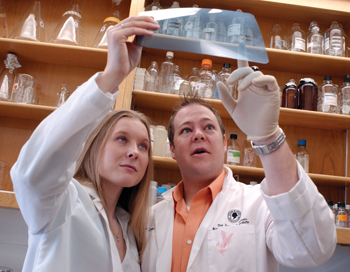
Robin Cobb and Kenneth Oestreich, graduate students in the lab of Eugene Oltz, Ph.D., discuss data.
Photo by Dana Johnson
DNA access key to immune system gene shuffle: study
The world is a dangerous place. Every day a universe of pathogens — bacteria, viruses and the like — bombard our bodies.
To counter these would-be intruders, our immune system generates billions of different “antigen” receptors in the hopes that a few will recognize an attacker, latch onto it, and target it for destruction.
The production of these varied receptors requires a complicated shuffling of gene segments, a process called DNA recombination, which can introduce genetic mistakes leading to leukemias and lymphomas. Failure of DNA recombination during immune system development can also result in severe immunodeficiencies, leaving patients susceptible to almost every type of infection.
Vanderbilt University Medical Center investigators are probing the early steps of the DNA recombination process — how the recombination “machinery” finds the right spots in the genome, gains access to the DNA, and cuts and pastes bits of DNA together. They report in the April issue of Immunity that small pieces of DNA within a particular T cell receptor locus control access and work together to coordinate the recombination process.
“We need to understand the basic mechanisms of the recombination process before we can understand how things go awry and lead to leukemias and lymphomas,” said Eugene Oltz, Ph.D., professor of Microbiology & Immunology.
The process that assembles billions of different antigen receptor genes is called V(D)J recombination. In essence, three gene “segments” — one V, one D, and one J — are cut and pasted together to produce a single gene for each different immunoglobulin (antibody) and T cell receptor. The process is something like shuffling three very large decks of cards and choosing a single card from each deck to create a unique combination, Oltz explained.
One of the ways that cells regulate this genomic cutting and pasting is by changing the availability of DNA. Nuclear DNA is wound tightly around proteins and packaged in a highly compacted form called chromatin. Tightly packed chromatin is not accessible for cutting and pasting; it has to be “unwound” for recombination to occur.
Kenneth Oestreich and Robin Cobb, graduate students in Oltz's laboratory, studied chromatin structure at a particular T cell receptor gene locus. They knew that small stretches of DNA called “accessibility control elements” (ACEs) were important in regulating the earliest steps of V(D)J recombination.
By examining chromatin structure in developing T cells, Oestreich and Cobb were able to demonstrate that one ACE opened chromatin over a very long stretch of DNA to expose many different “J” segments, while another opened a relatively short stretch of DNA to expose one “D” segment. D and J segments are cut and pasted together first in the V(D)J recombination process.
The students also showed that the two different ACEs communicate over long distances, forming a stable complex with each other.
“We've basically taken a snapshot photo of the gene locus at a particular point in time to show that a complex between these two ACEs exists,” Oestreich said.
“These ACEs have vastly different roles — one that's long range and one that focuses on a single gene segment. In the end, they come together to cooperate and open the lock that keeps recombination from occurring,” he added.
The two ACEs are both necessary for proper V(D)J recombination. Mice lacking one or the other of these ACEs cannot complete the initial steps, or any of the subsequent steps. They lack T cells and are immunodeficient, Oltz said.
It's interesting, the investigators noted, that one ACE “opens” such a long stretch of DNA but then cannot open the final segment without the other ACE. They are examining why that final segment is “privileged” and how it is protected from the function of the long-range ACE.
They also plan to identify the proteins that bridge the two ACEs together, Oltz said.
Although only limited genetic regions undergo the cutting and pasting of V(D)J recombination, many genes are controlled by ACE-like stretches of DNA. The findings that these elements regulate chromatin accessibility over short and long ranges and come together in functional complexes will have relevance for many different fields, the investigators said.
Steven Pierce at Vanderbilt, Jianzhu Chen, Ph.D., at the Massachusetts Institute of Technology, and Pierre Ferrier, Ph.D., at the Universite de la Mediterranee in Marseille, France, also contributed to the work. The research was supported by the National Institutes of Health and the Vanderbilt-Ingram Cancer Center.













